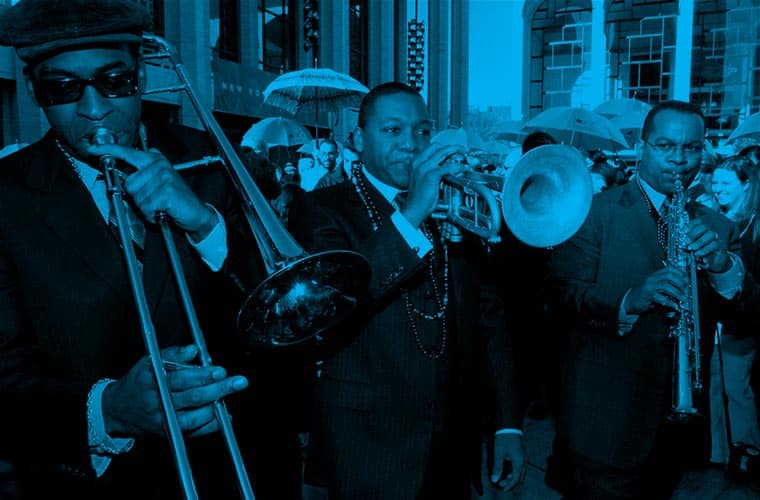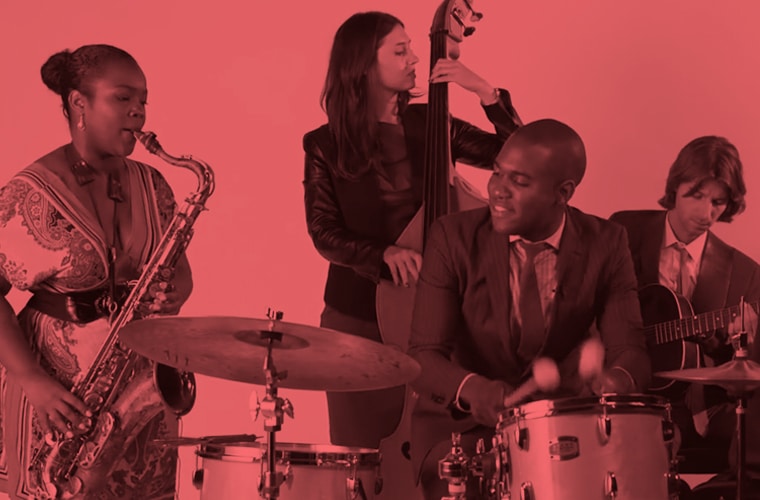Let Freedom Swing
Let Freedom Swing brings outstanding performances to community audiences. Offering performances, workshops, collaborations, and instrumental clinics for audiences of all ages, Let Freedom Swing explores a wide range of jazz topics through the lens of American history. Since 2013, Let Freedom Swing has reached over half a million people in over 3,500 concerts around the world.
EDUCATION
Jazz and Protest
“Jazz,” Duke Ellington once said is a “barometer of democracy.“ All through the years jazz has exemplified all that is most admirable about the country that created it –freedom, inclusiveness, individualism and a willingness to sacrifice one’s own interests for the greater good. But from time to time, musicians have also felt the need to use their art to protest when the United States fails to live up to its promises.
It started early. In 1929, Louis Armstrong turned a simple Broadway ditty called Black and Blue, into a searing indictment of racism. In 1943, in the middle of the Second World War, Duke Ellington presented Black, Brown, and Beige: A Tone Parallel to the History of the Negro in America in part to remind his countrymen that while fighting for freedom abroad, Americans should not forget those denied freedom at home. “I contend,” he said, that “it was a happy day when the first unhappy slave was landed on America’s shores. We stirred in our shackles, and our unrest awakened justice in the hearts of a courageous few, and we recreated in America the desire for true democracy, freedom for all, the brotherhood of man, principles on which the country had been founded.”
Jazz found ways to echo both the inspiration and the turbulence of the Civil Rights Era of the 1950’s and 60’s, as well. In 1956, when Arkansas Governor Orville Faubus sought to block integration of his state’s schools, the bassist Charles Mingus responded with a scathing piece called “Fables of Faubus.” That same year, when the State Department asked Louis Armstrong to represent the best of America behind the Iron Curtain, he said he wouldn’t go till they “straighten out that mess down south… They’ve been ignoring the Constitution.”


Victories and Anguish
Nineteen-sixty saw student sit-ins at segregated lunch counters all across the South. When Duke Ellington learned that black students had been turned away from a whites-only restaurant, he made sure he, too, was turned away and made headlines across the country. The drummer Max Roach, his then wife, the singer Abbey Lincoln, and the tenor saxophone master Coleman Hawkins combined forces to record We Insist! Freedom Now Suite, a torrent of anger and anguish that perfectly mirrored the rising tide of protest.
The Civil Rights movement won two great victories—the Civil Rights Act of 1964 and the Voting Rights Act of 1965. But they came at a fearful cost: civil rights workers murdered, marchers beaten, neighborhoods destroyed, the assassinations of Medgar Evers, John F. Kennedy, Malcolm X, Martin Luther King, Jr. and Robert F. Kennedy.
Amid the anguish, some African American musicians for a time abandoned the dream of an integrated art form. Other musicians, despairing at the chaos and turned inward, rejecting musical conventions in search of new forms of personal expression.
It is of course impossible to predict the future, either for jazz or for the United States. But however history unfolds, jazz musicians will be there, mirroring the country’s best traditions and pointing things out when things go wrong.
Key Figures

John Coltrane
Spirituality of one sort or another had always been an undercurrent in jazz, but in the 1960s JOHN COLTRANE, one of the most influential and adventurous saxophonists of the era, put forward the belief that music actually had the power to heal, and he brought an almost religious intensity to everything he played. Coltrane explored the harmonic freedom of modal jazz and the tones and textures of various world musics, and he tested the very limits of his instrument—all in search of a more profound musical meaning. Supported by an equally innovative and turbulent rhythm section, Coltrane developed one of the most powerful and explosive styles in jazz, known as “sheets of sound,” for the torrents of notes that streamed from his horn.
Spiritual though he was, Coltrane was hardly detached from the world around him. In 1963, when he learned that the bombing of an African-American church in Birmingham, Alabama, had killed four young girls, he drew on all his expressive resources to create a haunting musical elegy titled simply “Alabama.” This potent combination of seriousness and spirituality became a signature trait of this powerful performer. By 1964, when his landmark album “A Love Supreme” was released, John Coltrane had already achieved the status of idol among many fans and fellow musicians. “My music,” John Coltrane said, “…is the spiritual expression of what I am—my faith, my knowledge, my being…”

Nina Simone
Singer, pianist, composer, and civil rights activist, NINA SIMONE was born in Tryon, North Carolina in 1933. She learned to play piano at the age of four and sang in her church’s choir while still a child. After finishing high school, Simone won a scholarship to New York City’s Julliard School of Music to train as a classical pianist. She taught piano and worked as an accompanist for other performers while at Julliard, but eventually left school after running out of funds. Turning away from classical music, she started playing American standards, jazz and blues in clubs in the 1950s. Before long, she also started singing along with her music. Simone’s music defied standard genres. Her classical training showed through, no matter what style of song she played, and she drew from many sources including jazz, gospel, pop and folk. By the mid-1960s, Simone became known as a major voice of the Civil Rights Movement. She wrote “Mississippi Goddam” in response to the 1963 assassination of Medgar Evers and the Birmingham church bombing that killed four young African-American girls. After the assassination of Reverend Martin Luther King, Jr. in 1968, Simone composed “Why? (The King of Love Is Dead)”. She also wrote “Young, Gifted and Black,” borrowing the title of a play by Lorraine Hansberry, which became a popular anthem of the Civil Rights Era.
“Jazz calls us to engage with our national indentity. It gives expression to the beauty of democracy and of personal freedom and of choosing to embrace the humanity of all types of people. It really is what American democracy is supposed to be.”
— Wynton Marsalis
Jazz and Civil Rights Playlist

FREEDOM
The right to do what you want, to make your own decisions, and express your own opinions.

PROTEST
A statement or action expressing disapproval of or objection to something; also an organized public demonstration expressing strong objection to a policy or course of action.

SEGREGATION
The action of setting someone or something apart from others; also, in US history, the enforced separation of different racial groups.

What are Spirituals?
How do they influence Jazz music? Bryan Carter and his band tell you more and perform for you.

What is Free Jazz?
Drummer Bryan Carter and his band guide you through Free Jazz, an innovation in music that emerged in the 1950s. They show you how it’s played, and how to listen for it – check it out!